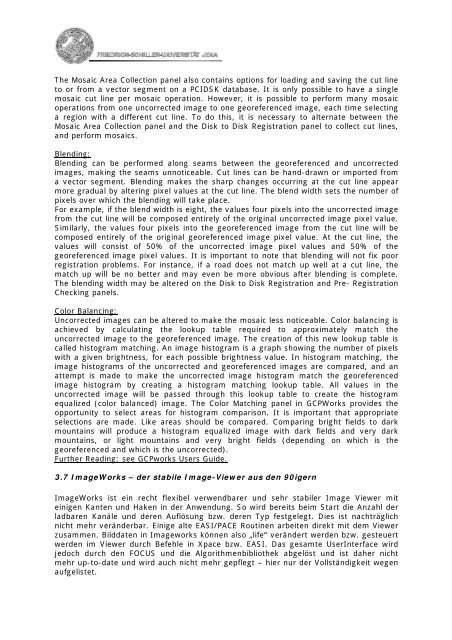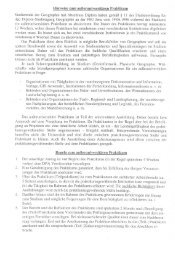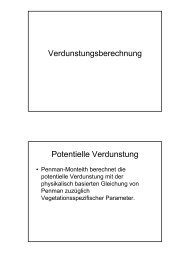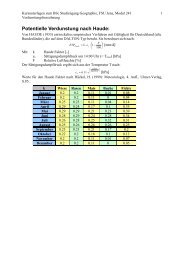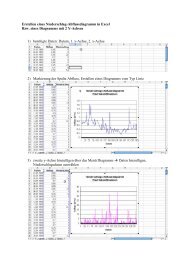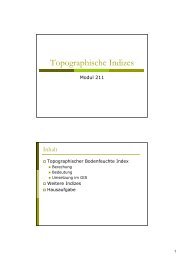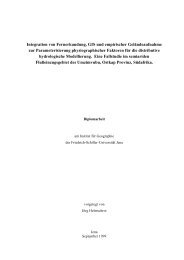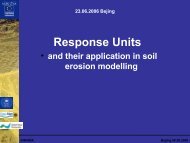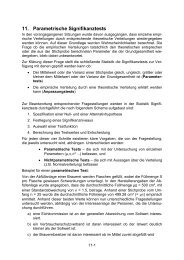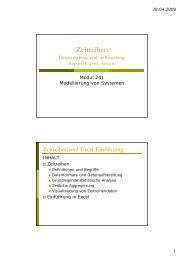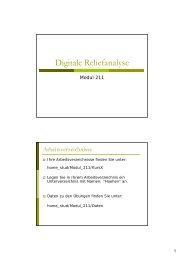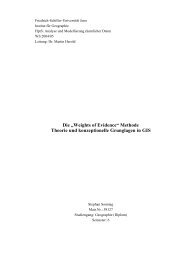Fernerkundung I (Digitale Bildverarbeitung) - Friedrich-Schiller ...
Fernerkundung I (Digitale Bildverarbeitung) - Friedrich-Schiller ...
Fernerkundung I (Digitale Bildverarbeitung) - Friedrich-Schiller ...
Create successful ePaper yourself
Turn your PDF publications into a flip-book with our unique Google optimized e-Paper software.
The Mosaic Area Collection panel also contains options for loading and saving the cut line<br />
to or from a vector segment on a PCIDSK database. It is only possible to have a single<br />
mosaic cut line per mosaic operation. However, it is possible to perform many mosaic<br />
operations from one uncorrected image to one georeferenced image, each time selecting<br />
a region with a different cut line. To do this, it is necessary to alternate between the<br />
Mosaic Area Collection panel and the Disk to Disk Registration panel to collect cut lines,<br />
and perform mosaics.<br />
Blending:<br />
Blending can be performed along seams between the georeferenced and uncorrected<br />
images, making the seams unnoticeable. Cut lines can be hand-drawn or imported from<br />
a vector segment. Blending makes the sharp changes occurring at the cut line appear<br />
more gradual by altering pixel values at the cut line. The blend width sets the number of<br />
pixels over which the blending will take place.<br />
For example, if the blend width is eight, the values four pixels into the uncorrected image<br />
from the cut line will be composed entirely of the original uncorrected image pixel value.<br />
Similarly, the values four pixels into the georeferenced image from the cut line will be<br />
composed entirely of the original georeferenced image pixel value. At the cut line, the<br />
values will consist of 50% of the uncorrected image pixel values and 50% of the<br />
georeferenced image pixel values. It is important to note that blending will not fix poor<br />
registration problems. For instance, if a road does not match up well at a cut line, the<br />
match up will be no better and may even be more obvious after blending is complete.<br />
The blending width may be altered on the Disk to Disk Registration and Pre- Registration<br />
Checking panels.<br />
Color Balancing:<br />
Uncorrected images can be altered to make the mosaic less noticeable. Color balancing is<br />
achieved by calculating the lookup table required to approximately match the<br />
uncorrected image to the georeferenced image. The creation of this new lookup table is<br />
called histogram matching. An image histogram is a graph showing the number of pixels<br />
with a given brightness, for each possible brightness value. In histogram matching, the<br />
image histograms of the uncorrected and georeferenced images are compared, and an<br />
attempt is made to make the uncorrected image histogram match the georeferenced<br />
image histogram by creating a histogram matching lookup table. All values in the<br />
uncorrected image will be passed through this lookup table to create the histogram<br />
equalized (color balanced) image. The Color Matching panel in GCPWorks provides the<br />
opportunity to select areas for histogram comparison. It is important that appropriate<br />
selections are made. Like areas should be compared. Comparing bright fields to dark<br />
mountains will produce a histogram equalized image with dark fields and very dark<br />
mountains, or light mountains and very bright fields (depending on which is the<br />
georeferenced and which is the uncorrected).<br />
Further Reading: see GCPworks Users Guide.<br />
3.7 ImageWorks – der stabile Image-Viewer aus den 90igern<br />
ImageWorks ist ein recht flexibel verwendbarer und sehr stabiler Image Viewer mit<br />
einigen Kanten und Haken in der Anwendung. So wird bereits beim Start die Anzahl der<br />
ladbaren Kanäle und deren Auflösung bzw. deren Typ festgelegt. Dies ist nachträglich<br />
nicht mehr veränderbar. Einige alte EASI/PACE Routinen arbeiten direkt mit dem Viewer<br />
zusammen. Bilddaten in Imageworks können also „life“ verändert werden bzw. gesteuert<br />
werden im Viewer durch Befehle in Xpace bzw. EASI. Das gesamte UserInterface wird<br />
jedoch durch den FOCUS und die Algorithmenbibliothek abgelöst und ist daher nicht<br />
mehr up-to-date und wird auch nicht mehr gepflegt – hier nur der Vollständigkeit wegen<br />
aufgelistet.


